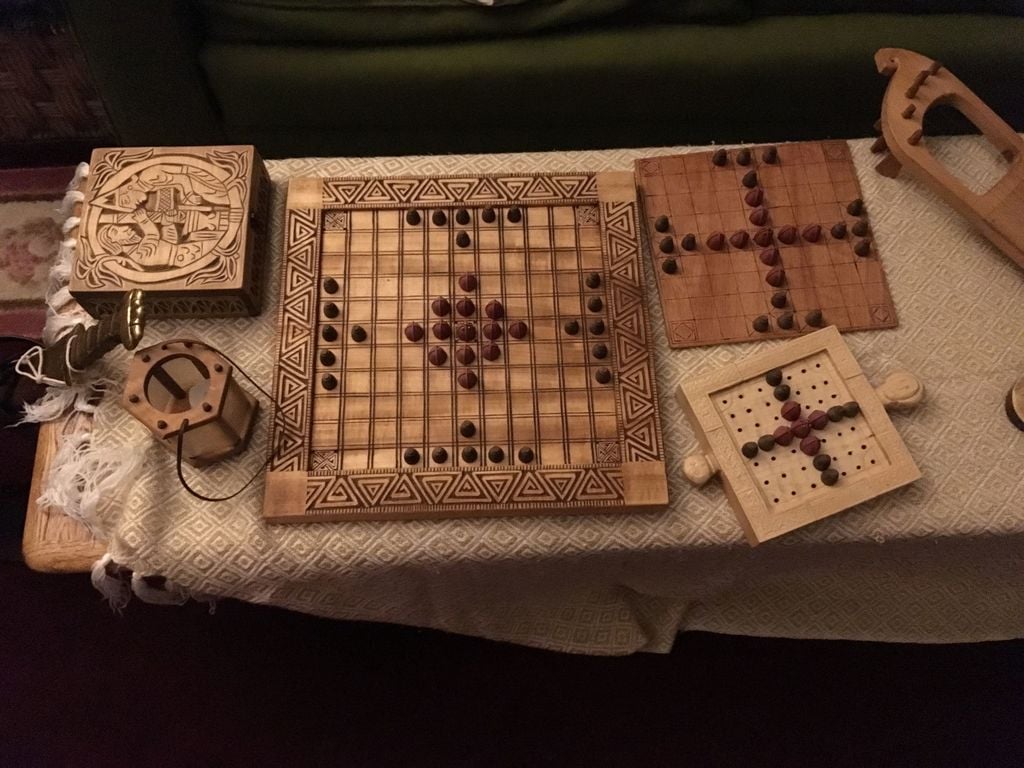
Tafl / Hnefatafl / Brandubh Pieces
thingiverse
This is a set of 3-D printing programs for playing the Tafl family of games - Hnefatafl, Tablut, Brandubh, Tawlbyrdd , and Alea Evangelii. All of these games appear to have evolved from the Roman game Ludus Latrunculorum in Scandinavia, and then spread to England, Ireland, Scotland and Wales with the Viking expansion and colonization of the 9th-to-11th Centuries. These designs are loosely based on cast-lead pieces found in a Viking camp in England. There are two different versions of each piece, to give you more options. Of course you can size the pieces up or down to suit your board or your preference. For Brandubh (Irish Hnefatafl, on a 7x7 board) you will need to print one King (called Brannan in Ireland), four defenders, and eight attackers. For Tablut (Saami/Finnish, on a 9x9 board) you will need to print one King, eight defenders, and sixteen attackers. For Tawlbyrdd, or Hnefatafl according to the Copenhagen rules (on an 11x11 board) you will need to print one King, twelve defenders, and 24 attackers. For Alea Evangelii (on a 19x19 board) you will need to print one King, 24 defenders, and 48 attackers. The voids in the bases can be filled with lead to weight your pieces, or with rare earth to make your pieces magnetic. If you are going to apply finish to your pieces, leaving the support material in the voids allows you to hold them on skewers while you do this. The pieces on which these are based were cast of lead, apparently with shape rather than color serving to differentiate them. Printing these with a metallic or aluminum-infused filament could help to approximate the appearance of the original pieces. Games of this family have had a convoluted history. Though largely supplanted by Chess in the Middle Ages, Tawlbyrdd (11x11) was described in Wales in 1587. In 1726 Swedish botanist Carl Linne observed Saami people playing Tablut, the 9x9 game. In the early 20th Century, chess historian H.J.R. Murray realized that Linne's description of Tablut held the key to understanding the Tafl family of games. Murray's interpretation of Linne's description results in an unbalanced game; but in recent years more nearly balanced interpretations have emerged. For more about these rules, by all means consult http://aagenielsen.dk/. Simon Spalding fullersteaching@yahoo.com ***** This project was another collaboration with Simon Spalding, being the second historical game set we have been working on, with the initial V1 set made in Tinkercad, and V2 pieces redone in OnShape as I practiced with Rotate, Sweep, and the Dimension constraint. Any questions about the historical nature of this set can be addressed to Simon at the email address above, and I will try to answer anything on modelling or future edits here in comments. -Ian R.
With this file you will be able to print Tafl / Hnefatafl / Brandubh Pieces with your 3D printer. Click on the button and save the file on your computer to work, edit or customize your design. You can also find more 3D designs for printers on Tafl / Hnefatafl / Brandubh Pieces.
